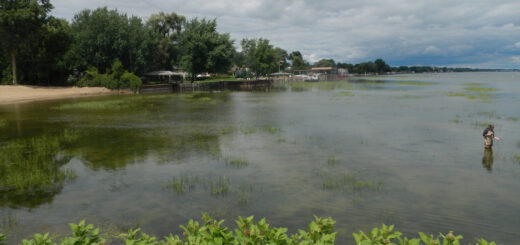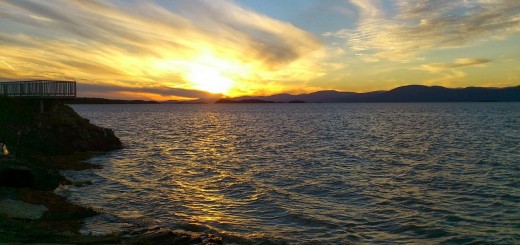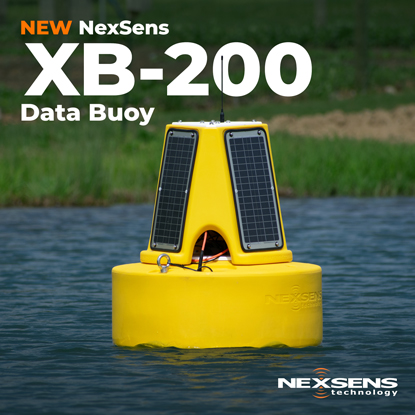Research Brief: Phosphorous Binding Treatments in Grand Lake St. Marys
0
Grand Lake St. Marys being treated with one of the phosphorous binding treatments (Phoslock) in early June 2021. (Credit: Stephen Jacquemin / Wright State University – Lake Campus)
Located in an agricultural watershed in northwestern Ohio, Grand Lake St. Marys is a hypereutrophic shallow reservoir that suffers from extensive cyanobacterial blooms throughout the year.
As both a recreational waterfront and a drinking water resource, such harmful algal blooms (HABs) can reach unsafe contact levels, deteriorating water quality and leading to beach closures.
In response to the blooms, management groups in the watershed have attempted to offset them with phosphorous-binding treatments. Such treatments include aluminum sulfate (alum) or lanthanum bentonite clay (Phoslock), which work by binding to dissolved phosphorous and forming floccules that sink to the sediment.
Ideally, phosphorous binding treatments can effectively prevent phosphorous release for decades. However, depending on the initial treatment dosage, lake morphology, degree of eutrophication, benthic oxygenation, and biota, the effectiveness of these treatments varies drastically, from days to decades.
A 2024 study published in Cambridge Prisms: Water assessed the efficacy of alum and Phoslock (pre-treated with a copper-based algaecide) in Grand Lake St. Marys over two years (2020 and 2021), seeking to determine whether the phosphorous binding treatments mitigated HABs and toxicity.1
The hypothesis of the study was that phosphorus binding treatments (e.g. alum and Phoslock would reduce algal biomass and microcystin toxin levels in the enclosed portion of Grand Lake St. Marys compared to the untreated main lake.
Methods

An algal bloom on Grand Lake St. Marys in late June 2021. (Credit: Stephen Jacquemin / Wright State University – Lake Campus)
The initial alum treatment was conducted on June 9, 2020, in the West Beach Enclosure, consistent with the timing and dosage of past treatment in Grand Lake St. Marys. The following year, “a combination of lanthanum-dosed bentonite clay (Phoslock) and copper sulfate algaecide (SeClear) were applied every 3-4 weeks from May to August 2021.”1
2021 treatments totaled out to four treatments of Phoslock and SeClear (May 13, June 11, July 2, and August 13) and one lone treatment of SeClear (July 23).
Site visits were conducted weekly from April 2020 through September 2021 in both the West Beach Enclosure and the main lake.
Physicochemical parameters (temperature, dissolved oxygen, pH, conductivity) were measured using a Eureka Manta 2 sonde, and total chlorophyll and phycocyanin pigment were measured using a BBE Moldaenke Algae Torch.
Measurements from the untreated area were then compared to measurements in the West Beach Enclosure.
Results
Compared to the expected duration of phosphorous binding treatment, in the case of the swimming enclosure within Grand Lake St. Marys, such treatments were rendered ineffective within a matter of days to weeks.
Due to the global pandemic, the original April/May treatment date was delayed until June 9 and—likely as a result of the delayed application, existing biomass of algae already present at that time of year, and the lake’s high pH–was largely ineffective.
While the Phoslock treatment yielded immediate decreases in chlorophyll and phycocyanin concentrations, reductions following the first four treatments only persisted for ~1 week, varying between treatments. The short time period may also have been due to water exchange between the enclosure and the untreated lake.
The fifth treatment (Phoslock + SeClear on August 13, 2021) had the longest-lasting impact at several weeks but also still converged with conditions in the main basin by mid-September.
None of the phosphorous binding treatments showed long-term success in controlling or mitigating cyanobacterial HABs, and their short-term success suggests that treatments would need to be repeated on a weekly basis.
Considering the costs of such treatments, the study concludes that it would be more effective for managers to invest funds in preventative measures that mitigate nutrient influxes for larger, hypereutrophic, shallow lakes like Grand Lake St. Marys.
Source
- Davidson JL, Jacquemin SJ, Newell SE, Hughes JC, Starr LD, McCarthy MJ. Ineffectiveness of phosphorus binding treatments in a semi-enclosed area of a large, shallow, and hypereutrophic lake. Cambridge Prisms: Water. 2025;3:e2. doi:10.1017/wat.2024.13













